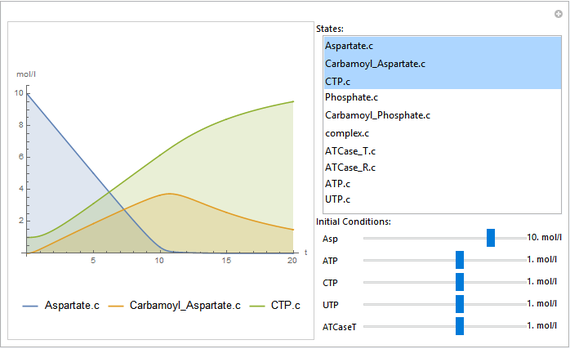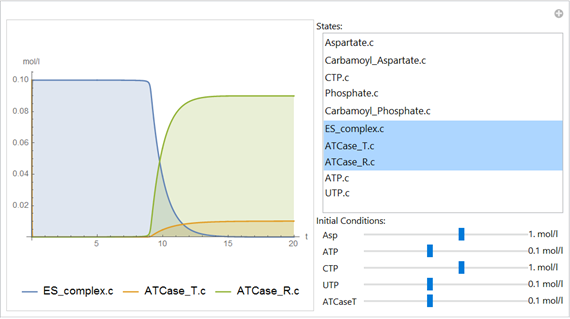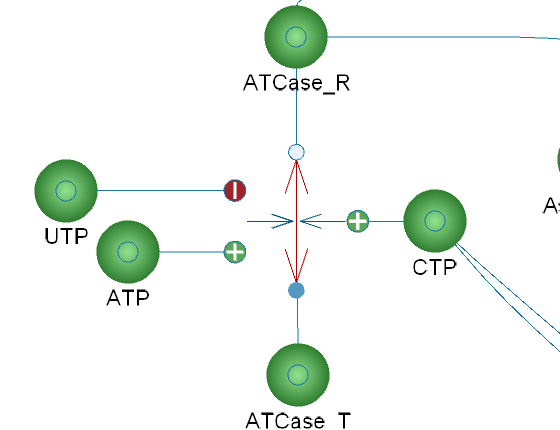Allosteric Regulation Explained with ATCase
Allosteric regulation is a prime drug target because it reduces the risk of overdose and side effects and can be used to fine-tune pharmacological processes. This model studies a naturally occurring allosteric reaction: the first step in the pyrimidine synthesis, catalyzed by the allosteric enzyme aspartate carbamoyltransferase (ATCase). The free BioChem Modelica library is needed to run this example; it can be downloaded here.
To run this example, you'll need
The latest versions of System Modeler and Mathematica.
Please make a selection:
Get afree trial Continue
with download
The Model
ATCase catalyzes the first step in the pyrimidine synthesization process and is affected by adenosine triphosphate (ATP), uridine triphosphate (UTP) and cytidine triphosphate (CTP). CTP is also one of the final products of the synthesis reaction chain, and if CTP or UTP is too low compared to ATP, then the activity of ATCase is increased to compensate. Activity of the ATCase is regulated by shifting the enzyme from a tense, low-affinity state to a relaxed, high-affinity state.
ATCase can be seen in the left part of the model in its two states, relaxed (ATCase_R) and tense (ATCase_T).
Visual Representation in SystemModeler.
The model has been built in SystemModeler, which results in a visual representation.
Simulation
Explore how parameters and initial conditions affect different states in the model by selecting which states to analyze and moving the sliders of the enzyme modifiers and the enzyme itself. The plot and the graphical interface are provided in the downloadable material.

Plot of how carbamoyl aspartate and aspartate change over time as the model simulates. As can be seen, the observed states can be switched by a menu on the right.
This method of analysis is useful when aiming to understand the properties of allosteric regulation. If ATP is increased, does it affect the overall reaction rate regardless of other substrate concentrations? Does UTP affect the equilibrium to a greater extent than CTP? Exploring how ATCase flows between states (tense, relaxed and enzyme-substrate complex) over time based on modifiers and substrate can assist in grasping the concept of allosteric regulation.

Plot of how ATCase switches between its states of tense, relaxed and enzyme-substrate complex. Initially, ATCase is almost exclusively in a complex state, but as aspartate runs out, it switches back into its relaxed and tense states.
Understanding allosteric regulation is essential when studying medicines, because allosteric sites can be a prime drug target. First, drugs targeting allosteric sites can modulate the structure of receptors, and thus adjust certain pharmacological responses. Second, potential toxic effects can be avoided, since a limitation in cooperavitity between the allosteric drug and an orthosterically binding ligand will avoid overdosing. Third, additional selectivity can be achieved by expressing only neutral cooperativity with uninteresting subtypes of an orthosteric ligand and high cooperativity with the interesting subtype, meaning fewer side effects of the potential drug.
Wolfram System Modeler
Try
Buy
System Modeler is available in English
and Japanese
on Windows, macOS & Linux »
Questions? Comments? Contact a Wolfram expert »
